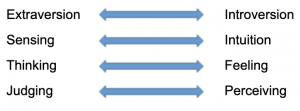The MBTI, Teams, and EI
The Myers Briggs Type Indicator, also known as the MBTI, is probably one of the most well-known personal assessment tools available. Whether someone completed the assessment while in college many years ago or with a team at work, it is rare to encounter someone who isn’t familiar with the instrument. This is especially true with teams from large organizations. What most people don’t know, however, is how many different ways there are to gain information from the tool and how strongly it supports emotional intelligence.
The core purpose of the tool is to help people increase their knowledge of self. Coincidentally, self-awareness is one of the cornerstones of leadership and emotional intelligence. Daniel Goleman, who is widely considered the father of emotional intelligence in the workplace, focuses his work on studying those skills beyond technical capabilities that are critical to professional success. His seminal work, which was initially published in 1995 and is continuously updated, identified five specific competencies necessary for optimal success, and they are as follows: self-awareness, self-regulation, self-motivation, empathy, and social skill. To this end, the most basic function of the MBTI is to increase one’s sense of self-awareness. What’s more is that the Myers-Briggs actually offers individuals tremendous insight to themselves by offering multiple types of reports with varying levels of depth and detail. Test-takers can get MBTI reports that speak to their behavioral proclivities in any of the areas below:
- communication style;
- managing change;
- conflict management;
- career choices options that will increase the likelihood that a person will be successful using their natural personality and preferences;
- decision-Making;
- chronic (and intense) stress; and
- how type impacts relationships and translates into certain behaviors at work, including one’s approach to problem-solving and the type of team player they tend to be.
The MBTI is able to provide such data by asking anywhere from 93 to 222 questions. The assessment aims to identify your preferences along four mental processes. Those processes are as follows:

Within each of these mental processes, there are nine specific preferences called facets that are also evaluated with the testing instrument. When these two pieces of information come together, they present a picture of the test-taker that even the test-taker may not have seen before. Interestingly, the picture presented is a reflection of how the test-taker sees him or herself. At the heart of the test is its design: it identifies one’s personal characteristics by asking different questions on the same topics in varying contexts to see how consistently the questions are answered. If one’s results are “all over the place”, that is an indication that person has gaps in their sense of self-awareness.
As a person better understands the MBTI tool and how the report(s), s/he is better positioned begin mastering to other prongs of Goleman’s model of emotional intelligence, specifically, self-regulation, empathy, and social skill. These prongs are particularly important to working with teams and the quality of those relationships. When organizations use the MBTI as part of their team-building strategy, employees get an opportunity to learn more about one another. The strength, however, of an MBTI workshop is found in the activities and questions that it helps team members to ask and answer about themselves and one another. In this process, employees develop greater respect and empathy for their distinct workstyles and preferences. In turn, this information gives them information that supports the development of self-regulation skills. When colleagues are better understood, their peers are more inclined to question their own attitudes and unproductive responses to those whose habits and preferences are opposite of their preference. Finally, self-regulation and social skill often develop in tandem as employees are motivated to exhibit more effective social skills in the name of greater collaboration and productivity.
Finally, an often overlooked benefit of the Myers Briggs is that its effectiveness is not limited to professional teams. This tool can be used with volunteer teams, church groups, nonprofit boards, and even in families and marriage counseling! The unifying element among individuals and teams who take the MBTI is a need to strengthen one’s self-awareness in order to have stronger interpersonal skills.



